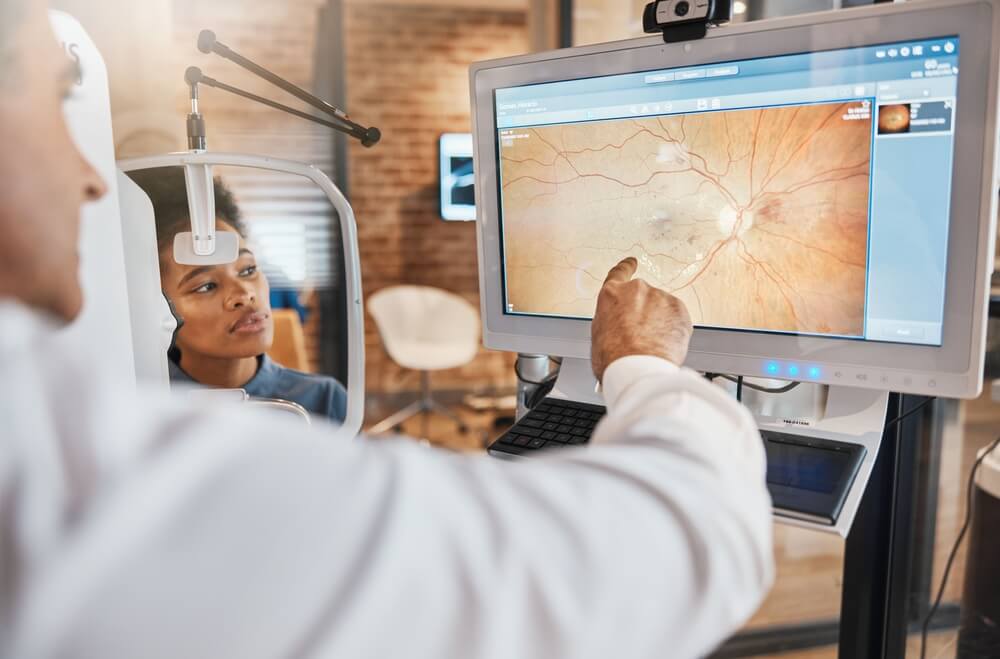Retina Treatments

Do you have a retina condition? At University Retina, our expert team of ophthalmologists is here to treat these conditions and preserve your vision. Treatments offered at our practice include:
Eye Injections
Eye injections, also called intravitreal injections, are a treatment that injects medication into the eye’s vitreous cavity. The vitreous cavity is where the vitreous humor gel is.
Delivering medicine to the vitreous humor can help treat age-related macular degeneration, diabetic retinopathy, and retinal vein occlusion. Undergoing these injections can help improve vision in patients with these conditions and save or preserve your remaining sight.
What to Expect While Receiving Eye Injections
If you need to receive eye injections, it helps to be prepared. First, you’ll receive an anesthetic, usually in the form of an eye drop, anesthetic gel, or sometimes a numbing injection.
After the medication has time to start working, an antiseptic will be placed on your eye and eyelids to prevent infection. You’ll have your eye open using a speculum, or your eye doctor will hold your eyelids open.
They will then ask you to look in a particular direction while they inject the medication. The needle is thin; you should only feel some pressure because of the numbing medicine.
You’ll have the injection placed in the white part of the eye. After receiving the injection, your eye will be cleaned and checked for any signs of complications or issues. In all, an eye injection usually takes about 10 to 15 minutes.
Intraocular Steroids
Intraocular steroids are steroids given in the eye. They are often given to patients to help reduce macular edema or inflammation. Macular edema may occur as a result of retinal vein occlusion.
They can also treat retinal conditions like exudative macular degeneration and posterior uveitis.
Laser Therapy
Laser therapy is a non-invasive treatment for several eye conditions like diabetic eye disease, retinal tear, and retinal detachment. These treatments can help slow down or prevent further progression of damage due to abnormal growth of blood vessels in the retina.
The damage usually occurs when blood sugar is too high, leading to diabetic retinopathy and vision loss if not treated. Using a laser helps target and treat specific parts of the retina, which these eye conditions affect.
What Do Laser Therapy Treatments Accomplish?
Laser therapy treatments are outpatient procedures. A laser is focused on the affected area of the retina. Next, the laser will create tiny burns on the retina.
These burns help seal off abnormal, leaking blood vessels affecting vision. By sealing off these blood vessels, any swelling in the retina can be reduced while also preventing the onset of further damage and preserving any remaining vision.
What is a Vitrectomy?
A vitrectomy is a surgical procedure that treats conditions inside the eye, like those that affect the vitreous. A vitrectomy involves removing the vitreous, a gel-like substance that fills your eye.
After removing the vitreous, it’s replaced with a gas bubble or a saline solution. Removing the vitreous gives a surgeon access to the retina. Having this access will allow them to repair any damage that may have occurred.
During a vitrectomy, the vitreous is removed from the eye using suction before replacing it with a gas bubble or saline solution. Using a gas bubble helps keep the retina in place during healing.
Patients must keep their heads in a particular position during recovery to ensure the gas bubble stays in place. They may also need to wear an eye patch and use eye drops to reduce inflammation and prevent infection.
Why Might I Need a Vitrectomy?
A vitrectomy is a way of treating conditions like macular holes, diabetic retinopathy, or retinal detachment. If you have a retinal detachment, a vitrectomy would be necessary to reattach your retina to prevent permanent loss of vision from occurring.
Patients with a macular hole may need a vitrectomy to remove the vitreous and effectively help close any holes in the macula. In the case of diabetic retinopathy, a vitrectomy can help remove any scar tissue or blood that’s built up or formed on the vitreous and is blocking or pulling on the retina.
Retina Surgeries Performed at University Retina
At University Retina, our specialized team of retinal doctors are board-certified, and fellowship trained in retinal surgery. We offer the following procedures to our patients:
Retinal Detachment Surgeries
Pneumatic Retinopexy
Pneumatic retinopexy is a procedure performed in-office that repairs some retinal detachments and does not require creating any incisions in the eye. Instead, a small gas bubble is injected into the vitreous, and then the head is positioned to allow the gas bubble to press up against the part of the retina that’s detached to help the tear or hole seal and heal.
Scleral Buckle Surgery
Scleral buckle surgery is a procedure that treats retinal detachment. The procedure places a scleral buckle, which is a small plastic or silicone band, around the eye. Putting this band around the eye helps support the retina while keeping it in place.
Vitrectomy
A vitrectomy is a surgical procedure that removes the vitreous and replaces it with a gas bubble or a clear solution. Your surgeon will then use a laser or other instruments to repair the detached retina.
Other Retinal Procedures Performed at University Retina
Macular Hole Surgery
Macular hole surgery uses procedures to repair a macular hole. A macular hole is a tear or opening in the macula. These are usually outpatient procedures performed using local anesthesia. Techniques used to repair macular holes include vitrectomy, face-down positioning after vitrectomy, and internal limiting membrane (ILM) peeling.
Diabetic Retinal Surgery
Diabetic retinal surgery, also called vitrectomy for diabetic retinopathy, is a procedure that treats advanced diabetic retinopathy. It involves removing the vitreous and replacing it with a gas bubble or clear solution.
Your surgeon will remove any weak and abnormal blood vessels or scar tissue on the retina that may cause vision loss. They may use a laser to seal off leaking blood vessels to prevent further retinal damage.
Sutured Intraocular Lens
A sutured intraocular lens or IOL is an artificial lens placed in the eye, usually during cataract surgery. A sutured IOL may be used if the natural lens capsule is too weak or suffered too much damage to hold a regular intraocular lens in place.
There may also be issues during the surgical procedure preventing the use of a regular IOL. Sutured IOLs may also be used for patients with certain eye problems, like eye injuries, previous eye surgeries, or other medical afflictions that affect how healthy their eyes are.
Today, find out the best way to treat a retina condition by requesting an appointment at University Retina!
Request an Appointment




